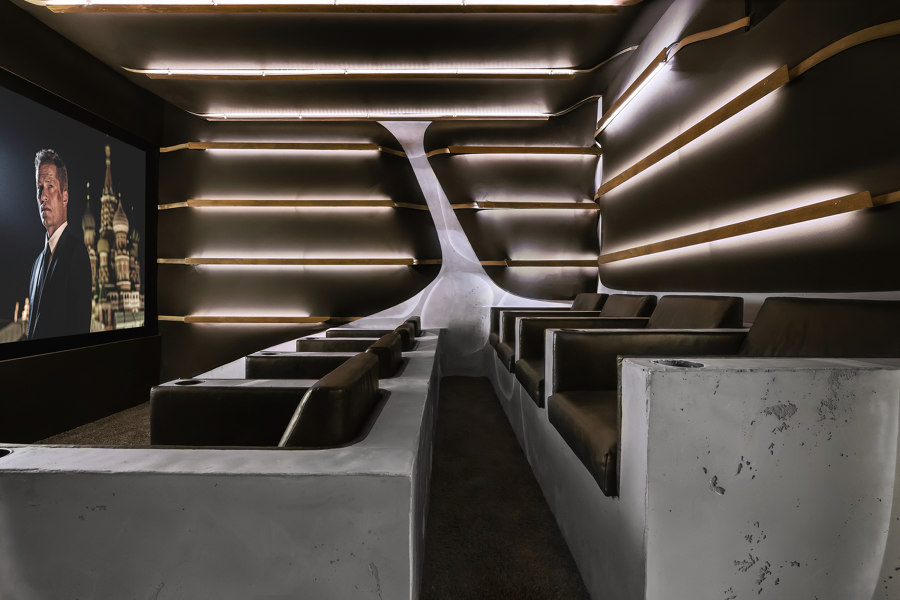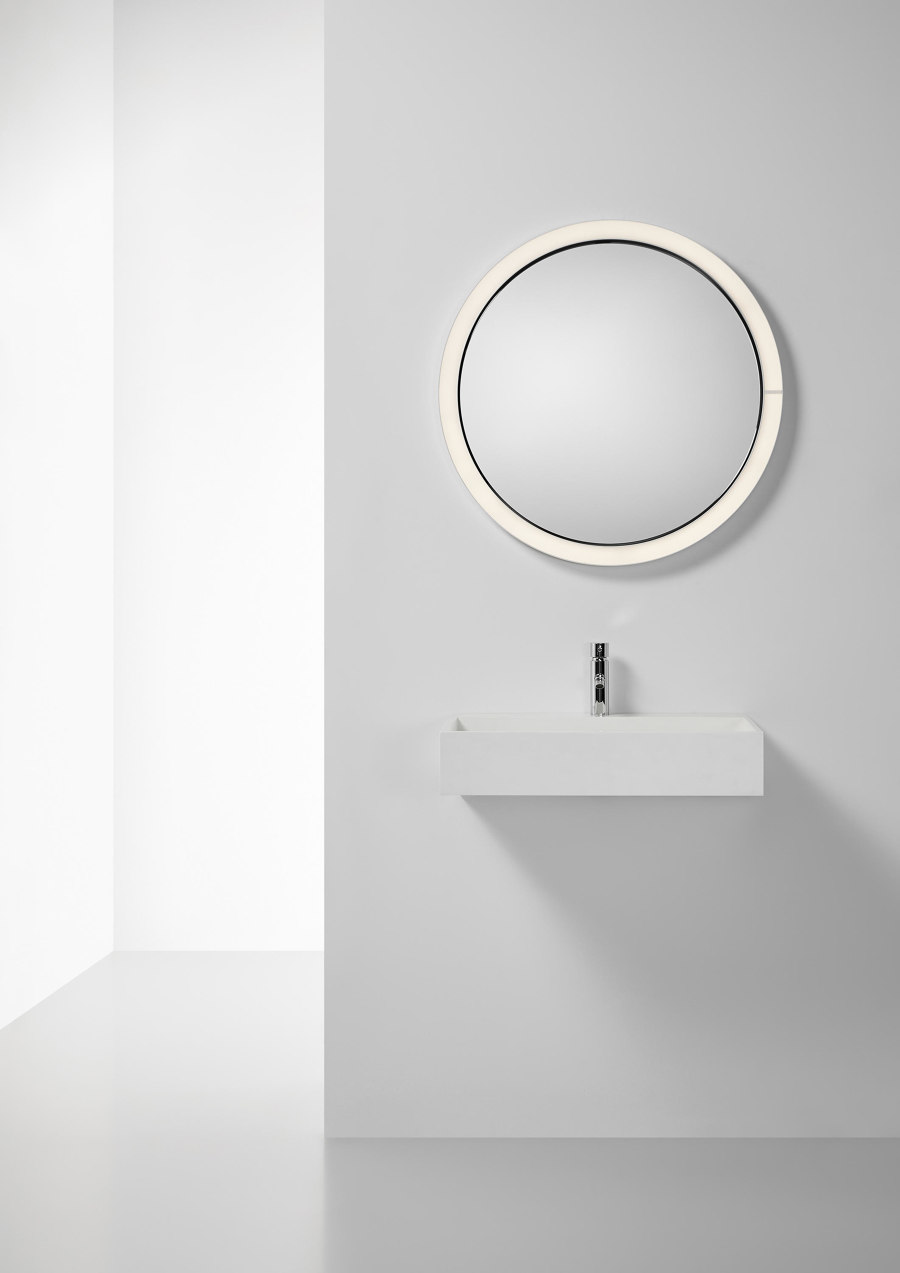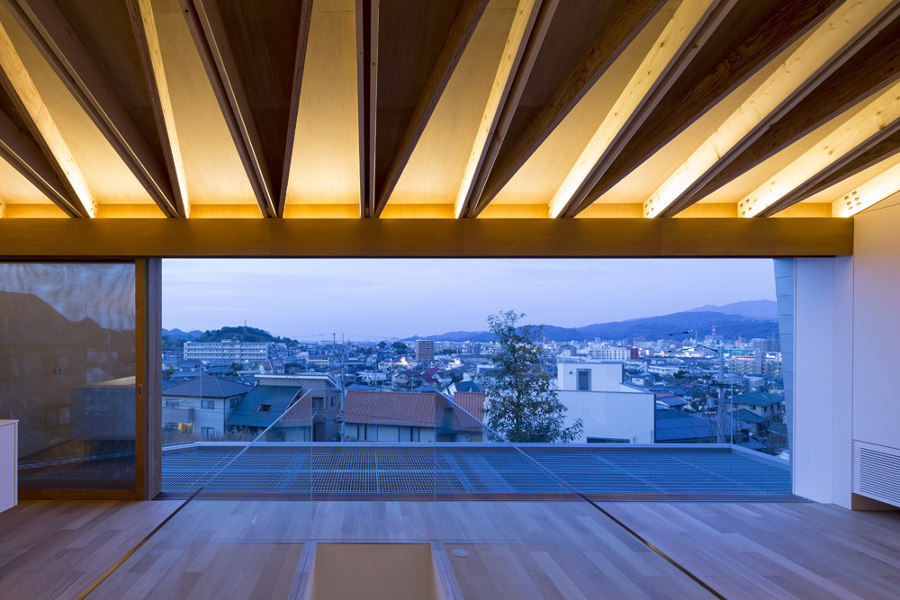Integrated lighting for intuitive spaces
Texte par James Wormald
21.11.22
Dark spaces can get new life by hiding integrated lighting in the architecture, while on a smaller scale, hyperlocal integrated lights give interiors more usability and purpose.
The Cumberland Entertainment Center by Barefoot Design is a private screening room for CGI studio The Scope in Berlin, Germany, and features bold indirect lighting. Photo: Michael Tewes

The Cumberland Entertainment Center by Barefoot Design is a private screening room for CGI studio The Scope in Berlin, Germany, and features bold indirect lighting. Photo: Michael Tewes
×Better for sight, better for eyes, better for health and better for moods, natural light is understandably the majority’s favoured method of illumination, but it’s an uncontrollable resource. It can be increased with larger windows, open-plan interiors and reflective or light-hued surfaces, but ultimately, when those cold winter nights draw in, the majority of our time is spent fumbling around in the dark.
It’s not all doom and gloom, however. Well-thought-out lighting concepts can entirely transform an interior environment. This home in Japan, for example, highlights its architectural features with hidden lighting, bringing them to life at night, while this small-scale showroom cinema also uses indirect lighting strips to graphically define its interior.
Indirect lighting at both Wrap (top, middle) and the Cumberland Entertainment Center (bottom) highlights their internal surfaces. Photos: Masao Nishikawa (top, middle), Michael Tewes (bottom)

Indirect lighting at both Wrap (top, middle) and the Cumberland Entertainment Center (bottom) highlights their internal surfaces. Photos: Masao Nishikawa (top, middle), Michael Tewes (bottom)
×Hyperlocal personalised lighting
During a power cut, for example, the enforced visual restriction first comes as a shock, but after edging through the house to find the candles, an atmosphere of familial camaraderie takes hold. Out come the dusty-boxed board games, voices become curiously hushed and an uplifting experience ensues.
By servicing specific tasks with hyperlocal lighting elements, larger groups can share open-plan areas
Along with a feeling of cosy togetherness, low-light environments also bring people more personalised comfort when they’re apart. Covering ceilings with rows upon rows of spotlights ensures workable light for all areas, but it can be like opening a door with a shotgun rather than the handle. By servicing specific tasks with hyperlocal lighting elements like reading lamps and piano lights, low-hanging pendants and integrated strip lighting, larger groups can share open-plan areas without invading the eyesight of others.
Recessed LED lighting strips like Light from Leicht Küchen AG (top) and Tribeca from Panzeri (bottom) bring functionality to sleek, minimalist kitchens

Recessed LED lighting strips like Light from Leicht Küchen AG (top) and Tribeca from Panzeri (bottom) bring functionality to sleek, minimalist kitchens
×Light-up kitchens
When applied to darker storage areas like kitchen drawers or deep cabinets and shelves, slim but powerful LED lighting strips like Light, from Leicht Küchen AG, can ensure everything stays visible. When recessed into the cabinet ceiling or under surface itself, like Tribeca from Panzeri, they make no physical impact on even the most minimalist of kitchens.
Fixed additional lighting components such as Dynamic LED Squash lights from Hera (top) and AREA under-cabinet lamps from Holy Trinity (bottom) are simple to install and operate

Fixed additional lighting components such as Dynamic LED Squash lights from Hera (top) and AREA under-cabinet lamps from Holy Trinity (bottom) are simple to install and operate
×If recessed lighting is too difficult to install, however – whether due to uncooperative surface materials or a lack of kitchen space – there are plenty of under-cabinet lighting products like the Dynamic LED Squash from Hera, that can be applied to any flat surface, without affecting the look from above. These AREA under-cabinet units from Holy Trinity, meanwhile, are movement operated, so there’s no need for extra trips to the light switch.
Soft integrated storage lighting like these waterproof FR 68-LED spots (top) and LED Top-Stick strips (bottom) from Hera allows users to find what they’re looking for, without ruining the lightscape

Soft integrated storage lighting like these waterproof FR 68-LED spots (top) and LED Top-Stick strips (bottom) from Hera allows users to find what they’re looking for, without ruining the lightscape
×Making storage more accessible
It’s not just kitchens that can benefit from a hyperlocal lighting network, of course. Whether soft like these recessed water-proof spots that add functionality to relaxingly low-light spa-level bathrooms, or more powerful LED strip lights that rule out having to choose between bright early morning disturbances or dressing in the dark – and the resulting fashion faux pas.
Emitting light from all around its wide circumference, the TR Moon light from Insolit with integrated mirror eradicates hand shadows

Emitting light from all around its wide circumference, the TR Moon light from Insolit with integrated mirror eradicates hand shadows
×An honest reflection: mirror lights
Whether sat on a dressing table, hung on a bathroom wall or even in a hallway, mirrors have an equally important role as other visual aids like desk lights or reading lamps. That's because it's crucial to get an honest and realistic reflection (however scary) when checking one's appearance. Mirrors with integrated lighting, especially those with light emitted from multiple directions like TR Moon from Insolit, stop shadows from interrupting the task.
House Mige by Oyo Architects in Ghent, Belgium (top), and the T60 bar by Movedesign in Fukuoka, Japan (bottom), both improve safety with step lighting. Photos: Luc Roymans (top), Ikunori Yamamoto (bottom)

House Mige by Oyo Architects in Ghent, Belgium (top), and the T60 bar by Movedesign in Fukuoka, Japan (bottom), both improve safety with step lighting. Photos: Luc Roymans (top), Ikunori Yamamoto (bottom)
×Rise of staircase safety lighting
Step lighting is a common, and indeed imperative, feature for exterior environments with stairs exposed to the elements. Inside the home, however, the feature is often ignored. With sleepy evening Sherpas tasked, instead, with either waking up the rest of the slumber party, or being one misstep away from serious injury.
Only a handful of wall-recessed step lights are required for subtle staircase safety measures here at House Mige in Belgium, but if hacking into the plaster is a no-no, lighting can also be housed inside the individual steps themselves. In the Japanese T60 wine bar, for example, hidden LED strip lights ensure the outline of the steps can be properly identified, without ruining the low-light ambience of the environment.
The Coworkrs workspace by Leeser Architecture directs workers with integrated strip lighting (top), while small recessed Mood wall lights from Simon keep hallways and landings safe at night (bottom)

The Coworkrs workspace by Leeser Architecture directs workers with integrated strip lighting (top), while small recessed Mood wall lights from Simon keep hallways and landings safe at night (bottom)
×Low-height recessed lights don’t necessarily need to stay near to the stairs either. At this co-working space in New York, LED strip lighting is used as an interior motif, leading and guiding employees towards and up the staircase. In more residential settings, meanwhile, in-set strips and wall lights like the Mood range from Simon can be left on as nightlights to create a gentle floor glow, guiding nighttime travellers on their passage.
© Architonic
Head to the Architonic Magazine for more insights on the latest products, trends and practices in architecture and design.






























